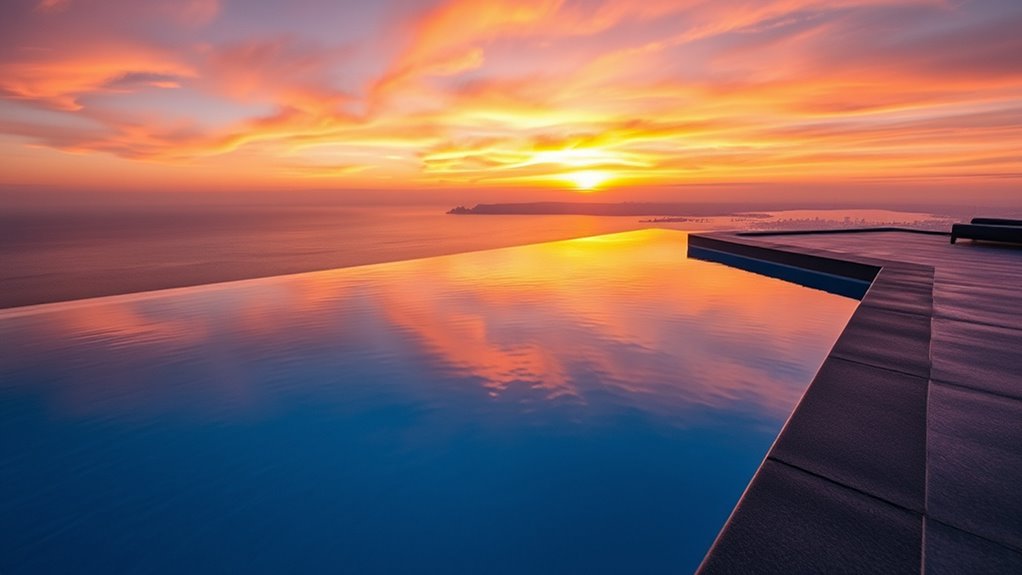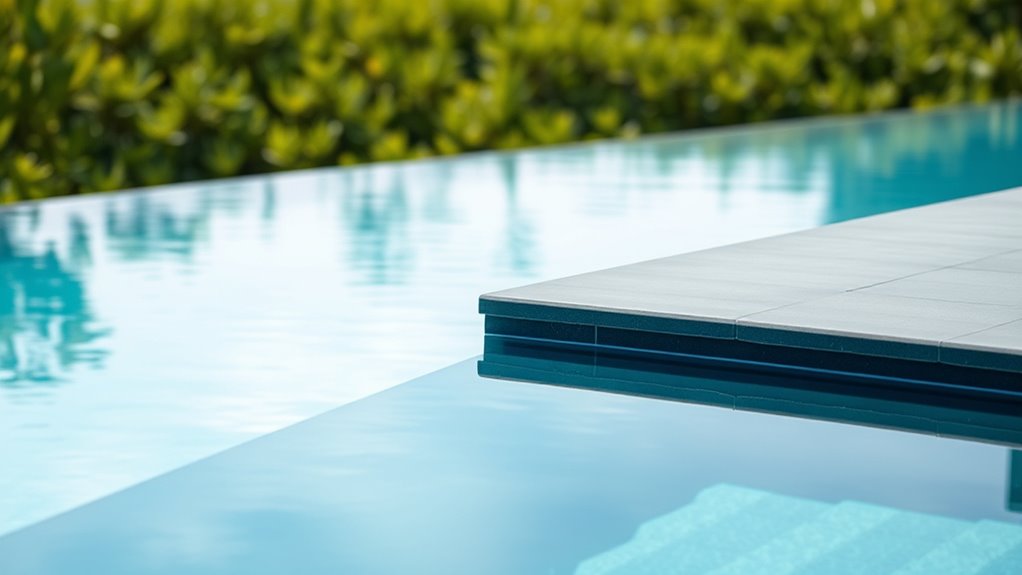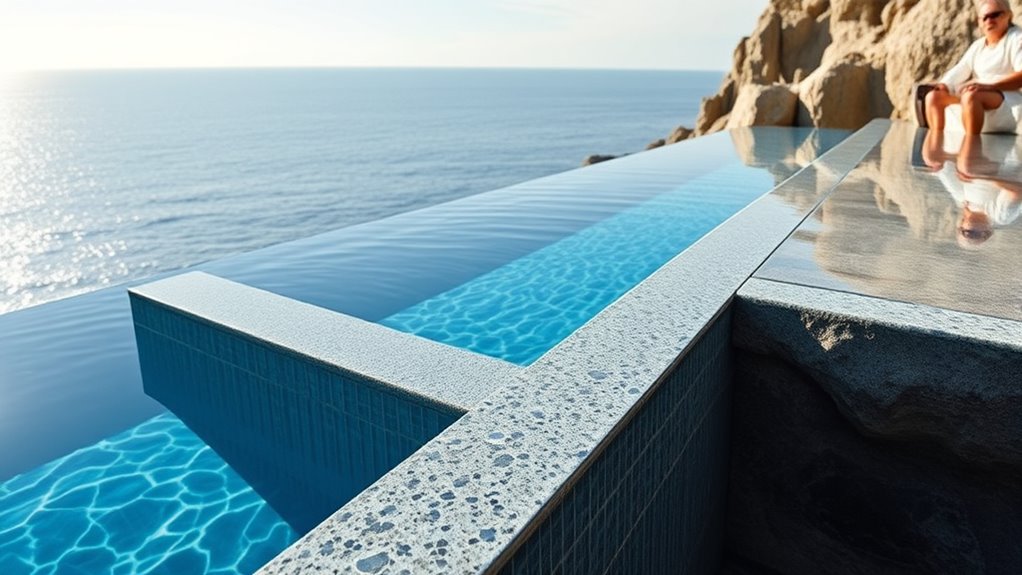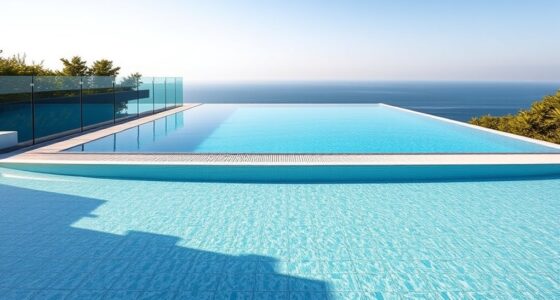When waterproofing your vanishing-edge pool, you should consider flexible sheet membranes like PVC or EPDM for durability and ease of installation. Liquid-applied coatings such as polyurethane offer seamless coverage, ideal for intricate designs. Proper application involves careful surface prep and sealing overlaps to prevent leaks. Maintenance includes regular inspections and prompt repairs. Your choice depends on pool size, shape, environment, and budget—continue exploring to find the best solution for your project.
Key Takeaways
- Flexible sheet membranes like PVC or EPDM are ideal for vanishing-edge pools due to their adaptability to complex shapes.
- Liquid-applied coatings such as polyurethane provide seamless waterproofing over irregular vanishing-edge surfaces.
- Proper sealing of overlaps and edges is crucial to prevent water leaks in the delicate edge areas.
- Consider environmental factors like UV exposure and saltwater, selecting durable membranes that resist these conditions.
- Regular inspections and maintenance ensure the integrity of the waterproofing system for continuous vanishing-edge performance.
Types of Waterproofing Membranes for Infinity Pools

When choosing waterproofing membranes for your infinity pool, it is vital to understand the different types available. The most common options include flexible sheet membranes, liquid-applied membranes, and spray membranes. Flexible sheet membranes are usually made of PVC, TPO, or EPDM, offering durability and ease of installation. Liquid-applied membranes, like polyurethane or bituminous coatings, create seamless, waterproof layers that conform to complex shapes. Spray membranes are applied with specialized equipment, providing even coverage over irregular surfaces. Each type has unique advantages, such as flexibility, chemical resistance, or ease of repair. Understanding waterproofing options is essential to selecting the most suitable system for your pool’s design and environment. Your choice depends on factors like the pool’s design, location, and maintenance requirements. Carefully evaluate these options to guarantee a reliable waterproofing system that withstands the pool’s environment and usage.
Application Techniques and Installation Considerations

Choosing the right waterproofing membrane is only part of guaranteeing your vanishing-edge pool performs effectively. Proper application techniques are vital to prevent leaks and ensure durability. Always follow manufacturer instructions carefully, including surface preparation, membrane placement, and sealing methods. Pay attention to overlaps, ensuring they’re properly sealed to avoid water ingress. Temperature and weather conditions can impact installation, so plan accordingly. Use appropriate tools to avoid damaging the membrane during installation. Consider the pool’s structure and movement to select flexible membranes when necessary. Regular inspection during and after installation helps catch issues early. Here’s a quick guide:
| Step | Key Action | Tips |
|---|---|---|
| Surface Preparation | Clean and smooth surface | Remove debris, repair cracks |
| Membrane Placement | Lay membrane without wrinkles | Use proper adhesives if needed |
| Sealing | Overlap and seal edges | Use compatible sealants |
| Inspection | Check for bubbles or gaps | Fix issues immediately |
| Final Testing | Fill with water, monitor leaks | Ensure watertight before finish |
Additionally, understanding the application process can help you achieve a more reliable and long-lasting waterproofing system.
Advantages and Limitations of Different Waterproofing Systems

Different waterproofing systems offer various benefits and drawbacks that can influence your pool’s performance and longevity. Membrane-based systems, like sheet or liquid-applied membranes, provide seamless coverage and excellent flexibility, reducing the risk of leaks. However, they can be complex to install and may require professional expertise. Crystalline waterproofing penetrates the concrete, offering durable, long-lasting protection, but it can be difficult to repair if damage occurs. Bituminous coatings are cost-effective and easy to apply, yet they may degrade over time when exposed to UV rays and weather. Epoxy-based systems deliver strong adhesion and chemical resistance, ideal for structural joints, but they tend to be more expensive and sensitive to surface preparation. Additionally, selecting the appropriate tuning approach can enhance the overall durability and performance of your waterproofed pool. Understanding these advantages and limitations helps you select the right waterproofing system for your vanishing-edge pool.
Maintenance and Inspection of Waterproofing Layers

Regular maintenance and inspection are essential to guarantee your vanishing-edge pool’s waterproofing layers remain intact and effective over time. You should routinely check for cracks, blisters, or signs of deterioration on the waterproofing surface. Look for water leaks or damp areas around the pool perimeter, which could indicate compromised layers. Clean debris and algae that might hide damage or cause deterioration, and ensure the waterproofing isn’t exposed to harsh chemicals or UV rays unnecessarily. Schedule professional inspections at least once a year to identify hidden issues early. Promptly address any damage by repairing or resealing affected areas to prevent leaks and water loss. Consistent maintenance helps extend the lifespan of your waterproofing system, ensuring your pool remains aesthetically pleasing and structurally sound.
Factors Influencing the Choice of Waterproofing Solution

Several key factors influence the selection of a waterproofing solution for your vanishing-edge pool, including the pool’s size, shape, and location. Larger pools may require more durable, high-performance materials to guarantee long-term waterproofing, while irregular shapes demand flexible solutions that accommodate curves and angles. The pool’s location also matters; pools in freeze-thaw zones need materials resistant to cracking, whereas pools near saltwater require corrosion-resistant options. Your budget and maintenance preferences play roles too—some waterproofing systems cost more upfront but last longer, reducing future repairs. Additionally, the existing pool structure and construction methods might limit your choices. Considering the latest industry standards, such as waterproofing longevity, can help ensure your pool remains protected over time. By evaluating these factors carefully, you can select a waterproofing solution that assures longevity, safety, and peak performance for your vanishing-edge pool.
Frequently Asked Questions
How Long Do Waterproofing Systems Typically Last in Vanishing-Edge Pools?
Waterproofing systems in vanishing-edge pools typically last 10 to 15 years with proper maintenance. You should inspect the system regularly for signs of damage, such as cracks or leaks, and address issues promptly. Using high-quality materials and professional installation can extend the lifespan. Keep an eye on weather conditions and chemical levels, as extreme changes can accelerate wear and tear, ensuring your pool remains secure and leak-free for years.
Are There Eco-Friendly Waterproofing Options Available for Infinity Pools?
Yes, eco-friendly waterproofing options are available for infinity pools. You can choose sustainable materials like plant-based sealants, recycled rubber membranes, or bio-based coatings that reduce environmental impact. These options often contain fewer chemicals and are safer for the ecosystem. By selecting eco-conscious products, you help protect waterways and wildlife while maintaining the durability and performance needed for your vanishing-edge pool.
What Are the Cost Differences Between Various Waterproofing Systems?
You’ll find that the cost differences between waterproofing systems depend on materials, installation complexity, and durability. EPDM rubber offers affordability and flexibility, while PVC membranes are mid-range, providing good longevity. Liquid waterproof coatings tend to be more budget-friendly but may require frequent repairs. High-end options like fiberglass or specialized sealants cost more upfront but deliver longer-lasting protection. Consider your budget, maintenance preferences, and desired lifespan to choose the best fit.
Can Waterproofing Materials Be Repaired if Damaged?
Yes, waterproofing materials can be repaired if damaged. You should assess the damage to determine if it’s localized or widespread. Minor cracks or punctures can often be fixed with patching or sealants designed for the specific material. For larger issues, you might need to remove and replace sections of the waterproofing layer. Regular inspections help catch problems early, making repairs easier and more effective.
How Do Climate Conditions Affect Waterproofing Performance?
Climate conditions profoundly impact waterproofing performance. If you’re in a region with extreme temperatures, your waterproofing materials might expand or contract, leading to cracks or fissures. Heavy rainfall or humidity can cause the materials to deteriorate faster or promote mold growth. Snow and ice can cause freeze-thaw cycles, damaging the integrity of the waterproof layer. Regular inspections and choosing climate-appropriate materials help guarantee longevity and effectiveness.
Conclusion
Choosing the right waterproofing system for your vanishing-edge pool is like selecting the perfect brush for a masterpiece — it guarantees your vision remains flawless. By understanding the types, application methods, and maintenance needs, you can prevent leaks and preserve your stunning infinity view. With proper care, your pool will stand as a mirror to the sky, a proof to your smart choices. Remember, a well-protected pool is the foundation of endless, shimmering serenity.










